Grooming your pet and knowing what goes into it is necessary when doing it yourself. In this guide, we’ll equip you with the tips and tricks to ease the grooming process.
Source: Basic Grooming Tips From A Dog Grooming Professional
- Nail Trimming
- Brushing
- Teeth Brushing
- Bathing
- Ear Cleaning
- Eye Cleaning
- Paw Cleaning
- Hair Trimming
- Training Your Dog to Enjoy Grooming
Read more The Ultimate Guide to Grooming and Bathing Your Dog
Nail Trimming
Recommended frequency: every 1 – 2 months
A good indication is when your dog’s nails make a clicking sound when he’s walking.
Why Do You Need to Trim Your Dog’s Nails?
- Comfort when walking or running When his nails get too long, it’s likely that he’ll change his walking style to adapt to the pain. This may cause joint pain, joint misalignment or arthritis in the long run.
How to Trim Your Dog’s Nails
- Choose a well-lit spot to trim your dog’s nails.
Source: How to Use Dog Nail Clippers
- Position him comfortably such that his paw is facing upwards.
- Hold his foot firmly but gently and ensure that he’s calm.
Hagen Dog & Cat Nail Clipper (Medium)
- Using a nail clipper for dogs, start by snipping bit by bit.
- Refrain from cutting too deep to prevent any bleeding.
For dogs with white nails, look out for a black dot – that’s when you’re getting close to the quick and should stop cutting.
Tip!
Source: Anatomy of a Dog’s Paw with a Labelled Diagram
Apart from checking your dog’s nails every now and then, note that his dew claws require more attention than the rest as they don’t get worn down as much.
Brushing
Recommended frequency: 1 – 2 times a week
Why Do You Need to Brush Your Dog’s Fur?
- Maintain their coat health and shine by spreading the natural oils
- Reduce shedding
- Prevent skin wounds or infections by getting rid of mats
- Early detection of fleas and ticks
Read more 7 Reasons Why You Should Brush Your Dog’s Coat On A Regular Basis
Which Brush Should You Use?
Getting the right dog brush will make the grooming process more comfortable and effective.
Here’s what to get based on your pet’s coat length or type:
| Coat Length/Type | Best Brush |
|---|---|
| Very Short e.g. Boston Terrier, Great Dane |
 Rubber Brush (Kudi Pet) Rubber Brush (Kudi Pet) |
| Short e.g. Labrador, Pug |
 Slicker Brush (Biogance) Slicker Brush (Biogance) |
| Short & Thick e.g. Husky, German Shepherd |
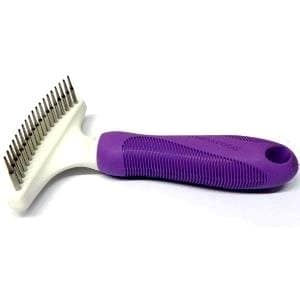 Rake Comb (Tommy&Coco) Rake Comb (Tommy&Coco) |
| Medium e.g. Golden Retriever, Border Collie |
 Bristle Brush (Biogance) Bristle Brush (Biogance) |
| Straight & Silky e.g. Maltese, Shih Tzu |
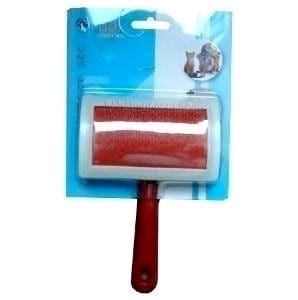 Slicker Brush (Kudi Pet) Slicker Brush (Kudi Pet) |
| Curly e.g. Poodle, Bichon Frise |
 Pin Massage Brush (Biogance) Pin Massage Brush (Biogance) |
| Wiry e.g. Terriers, Schnauzer |
 Comb With Metal Teeth (Wild) Comb With Metal Teeth (Wild) |
| Double-coated e.g. Golden Retriever, Husky |
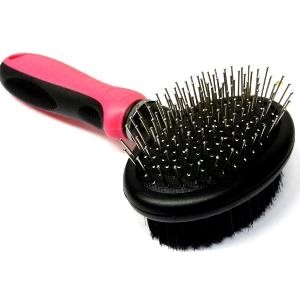 Pin & Bristle Brush (Tommy&Coco) Pin & Bristle Brush (Tommy&Coco) |
Note: most dogs usually require more than one type of brush.
If you’re looking for another brush, Foolee’s de-shedding tools are suitable for all dogs.
- Foolee De-shedding Tool
- Foolee Easee Brush Head + Folee Easee Shedding Tool (brush head is interchangeable)
Teeth Brushing
Recommended frequency: 2 – 3 times a week
Why Do You Need to Brush Your Dog’s Teeth?
- Eliminate bad breath
- Remove tartar and plaque
- Prevent gum disease and damage to internal organs
How to Brush Your Dog’s Teeth
Petosan Dental Kit (Toothpaste & Toothbrush)
- Ensure that you have the right dental care products, including dog toothpaste and toothbrush.
It’s crucial to use only toothpaste and toothbrushes made specifically for dogs.
Finger brushes may be used for smaller dogs, whereas those with longer handles are more suited for larger dogs. Dog toothpaste will also come in edible flavours, as dogs are not taught to spit toothpaste out.
- Get in a comfortable position where you can brush your dog’s teeth easily.
- Prep him for the brushing.
Test if your dog is willing to get his teeth brushed. Try rubbing your finger against his teeth and gums gently and let him taste the toothpaste.
This is for him to get accustomed to the procedure.
Source: 7 Tips For Doggie Dental Care
- Test out the toothbrush and start slow.
Lift his upper lip and start brushing with toothpaste gently.
Tip!
Angle the brush at 45 degrees from his teeth. This will help to eliminate plaque more effectively while massaging the gums.
- Brush in a circular motion.
Check for any bleeding when brushing. Light, occasional bleeding is fine, but if it gets heavy and excessive, it’s time to consult your vet.
- Create a calming and encouraging environment.
Your dog can sense your feelings, so if you remain composed and encouraging during the process, he’s more likely to cooperate.
Tip!
Source: Description and Physical Characteristics of Dogs
Take it slow when introducing brushing to your pup.
Try starting on the parts where plaque accumulates (outsides of canine and molars). Then, with every brushing session, progress to the insides.
Bathing
Recommended frequency: every 2 weeks
Why do you need to bathe your dog?
Maintain hygiene Check for any wounds or parasites
Things to Take Note of When Bathing Your Dog
Source: How To Get Your Dog To Love Bath Time
- Brush your dog before a bath
Remove mats before wetting your dog. Otherwise, it’ll worsen any tangles.
Isle of Dogs Coature No. 12 Triple Strength Epo Shampoo (1litre)
- Use a dog shampoo
Dogs require a gentler shampoo than humans and even babies.
- Have everything you need within reach
Be well prepared. During the bath, your dog should never be left unattended. Thus, it’s important to ensure that the shampoo, cotton balls (for ears) and towel are nearby.
- Place a bath mat for them to stand comfortably on without slipping
- Use slighted heated water
Tip!
Install a water spraying attachment instead of using a cup.
- Avoid getting shampoo in their eyes and ears!
- Rinse thoroughly with water
Leaving shampoo on your dog’s fur may lead to skin irritation and infections.
- For drying, set hairdryer to cool setting
How to Bathe Your Dog
Source: How Often You Should Bathe Your Dog (Plus 8 Bathing Tip
Ear Cleaning
Recommended frequency: every 2 weeks
Why Do You Need to Clean Your Dog’s Ears?
- Prevent infections
- Remove dirt and ear mites
- Maintain optimum bacteria balance
Note!
Ensure that you don’t over-clean your dog’s ears!
That may lead to the removal of healthy bacteria that helps to fight against harmful organisms.
How to Clean Your Dog’s Ears
Virbac Epi-otic III Ear Cleanser (125ml)
All you need is: your preferred ear cleaning solution and some cotton balls.
- Sit on the floor and position your dog such that he’s comfortable and you’re able to hold on to an ear to clean it.
Source: Ear Structure and Function in Dogs
- Hold the pinna (or ear flap) up vertically while holding the ear cleaning solution in your other hand.
- Squeeze some solution into his ear.
It’s okay for the cleaner to spill out of the ear.
Note!
DO NOT let the tip of the bottle touch the ear.
If that happens, dip a clean cotton ball into alcohol and wipe the tip to get rid of bacteria.
- While still holding the ear up, give a gentle massage to the bottom of the ear.
You’ll be able to hear the liquid move down the ear canal. This helps to clean the entire ear thoroughly.
- Let your dog shake out any extra solution.
- Then, hold his ear up and use a cotton ball to clean any debris and liquid.
Read more Instructions for Ear Cleaning in Dogs
Eye Cleaning
Recommended frequency: every 2 weeks
Why Do You Need to Clean Your Dog’s Eyes?
- Prevent infections
Methods You Can Use to Clean Your Dog’s Eyes
Eye Envy Tear Stain Remover Solution for Dog (240ml)
- Wipe with a tear stain removal solution
Use either a sponge, cloth or gauze to do this. Wet it with just enough solution to wipe any dirt off your pet’s eyes.
Avoid using tissues or paper towels as they’ll shred when wet and irritate the eyes.
Note!
You should be wiping in the direction away from your dog’s eyes, i.e. from the inside to the outside.
- Wipe with moist wipes
This is the convenient solution. However, ensure that the wipes are made specially for dogs.
When wiping your dog’s eyes, be gentle and do not touch his eyes.
Bio Groom Stain-free Eye Stain Cover Cream (7oz)
- Cover with face cream or powder
For dogs with white fur, using face cream/powder helps to blend any tear stains away. This is a safer but less permanent solution than wiping.
- Trim stained fur off
Only use clippers if you dog is calm and tolerant of it. Otherwise, get help from a professional groomer.
Tip!
If you find it hard to remove any secretion, it may have hardened.
You can use a moister cloth or wipe and give it several gentle strokes so that it’ll soften and get removed more easily.
Paw Cleaning
Recommended frequency: every 2 weeks
Source: Cleaning a Dog’s Paws
Why Do You Need to Clean Your Dog’s Paws?
Remove any dirt stuck in between their toes Attend to any wounds or cuts immediately Prevent irritation due to dirt accumulation
Ways to Clean Your Dog’s Paws Effectively
- Buy dog boots for your pet
If you prefer to keep your dog’s paws clean at all times, wearing dog boots is the solution.
- Get your dog accustomed to foot touching
Once he’s used to the idea and feeling of getting his feet touched, the process would be smoother.
Make him comfortable by starting slow – give constant encouragement and treats.
Proteger Pet Wipes Olive Leaf Extract and Aloe Vera (100 pieces)
- Wipe with pet wipes
- Use shampoo to wash
This can be done during baths, or whenever he steps onto something that is harder to remove.
Note!
Always remember to check for dirt between his toes.
Gentle separate the toes to check for any dirt or extra hairs – trim those hairs to prevent dirt collection.
Hair Trimming
Recommended frequency: every 2 months
Why Do You Need to Trim Your Dog’s Hair?
Prevent matting Improve comfort
Preparation Needed Before Cutting Your Dog’s Hair
- Purchase a full set of grooming scissors
| Type of scissors | Function | Example |
|---|---|---|
| Straight scissors | General cutting | 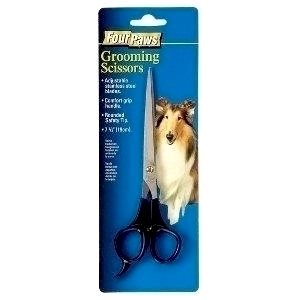 Four Paws Grooming Scissors (7.5″) Four Paws Grooming Scissors (7.5″) |
| Rounded tip scissors | Cutting sensitive areas like face and tail | 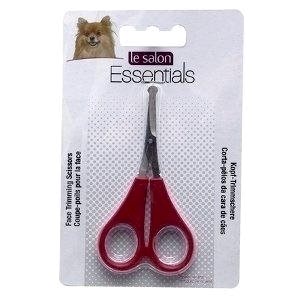 Hagen Essential Face Trimming Scissors Hagen Essential Face Trimming Scissors |
| Thinning scissors | For problem areas and giving your pet’s coat a natural look |  Doggyman Pure Pretty Trimming Thinning Scissors Doggyman Pure Pretty Trimming Thinning Scissors |
- Set up a grooming station
Place a mat underneath your pet so that when done, you can easily throw the hair away. Also, ensure that all your grooming tools are within reach.
- Grooming scissors should be sharpened and oiled
This ensures a clean cut to prevent tugging on your pet’s hair.
How to Cut Your Dog’s Hair
Source: How to Cut Dog Hair with Scissors at Home – DIY Dog Haircut
- Start by combing his coat to get rid of mats
You can also choose to trim his hair after a bath when his coat is damp.
- Decide on your preferred length
There’s no restrictions to the length of the coat, as long as you don’t cut too near to their skin. To ensure that you cut evenly, use your finger as a ruler.
- Work from the front to the back of the body
Work calmly and carefully.
- Deal with delicate areas last
Trim the more essential parts before the sensitive areas like the face and tail, so if your dog gets restless, at least the bulk of it is done.
- Finish off by using the thinning scissors to trim any matted or thick patches
Tip!
Only cut if you can see through the hair when you hold it up!
If you can’t, it means you’re getting too close to your dog’s skin and should stop.
Another way to prevent cutting your dog’s skin is to use a comb.
It’s best to keep a comb between the dog’s skin and the scissors, as this will help prevent you from cutting the dog’s skin.
Training Your Dog To Enjoy Grooming
The key to nailing DIY grooming is comfort and consistency.
Take it slow and make the environment as comfortable for your pet as possible. Give him his favourite treat after its done so he’ll associate the experience with positive reinforcement.
Once he’s used to the routine, he’ll be calmer and the process will be smooth sailing.
The bottom-line is: When in doubt, go to a trusted pet groomer – it’s cheaper than going to a vet.
In that case, take note of these tips before sending your pet for grooming.
This article on dog grooming tips was first published on Pet Lovers Centre.